Abstract
[G-3H]Dopamine (3,4-dihydroxyphenethylamine) metabolism in human skin fibroblasts and rat hepatoma cells in culture was determined by high-pressure liquid-chromatographic analysis of both cell extract and uptake medium. Conjugated metabolites were selectively hydrolysed by incubation with arylsulphatase or beta-glucuronidase before analysis. The principal metabolites of dopamine in fibroblast cells are 3-methoxytyramine 4-O-sulphate and 3-methoxytyramine. No significant differences, either in the amounts of these metabolites or in the amount of dopamine metabolism, were observed in fibroblasts from both normal and homocystinuric individuals. In rat hepatoma cells, the major metabolite of dopamine was 3-methoxytyramine 4- or 3-O-glucuronide; lower concentrations of dopamine 4- or 3-O-glucuronide, 4-hydroxy-3-methoxyphenylacetic acid, 3,4-dihydroxyphenylacetic acid and two unidentified glucuronide conjugates were also observed. Significant differences in the relative concentrations of these metabolites in cell and uptake medium were observed in both cell systems.
Full text
PDF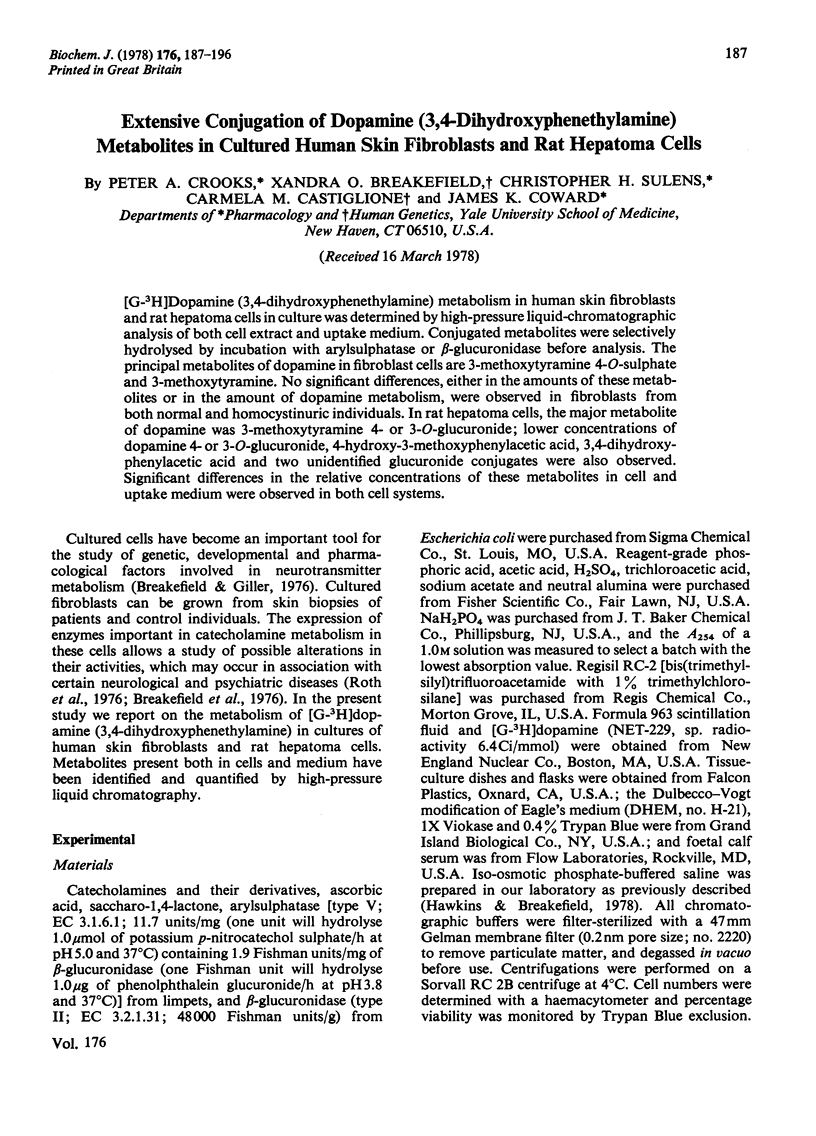
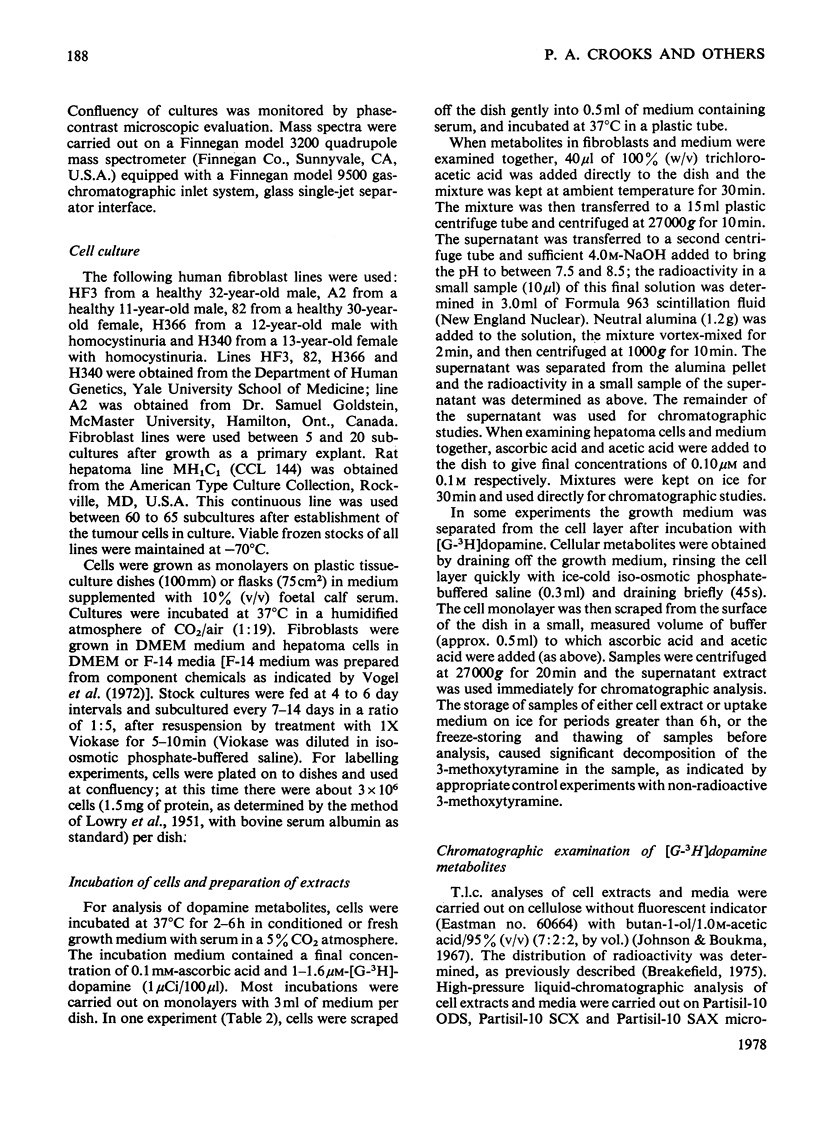
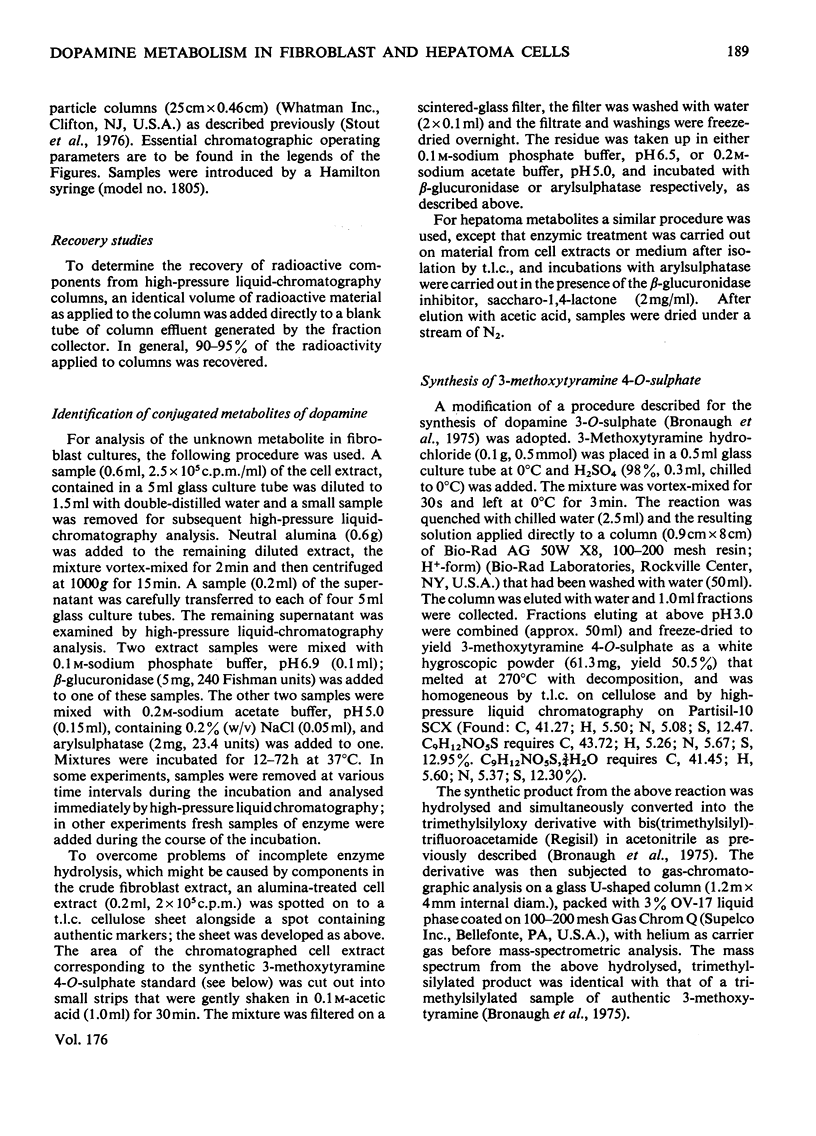
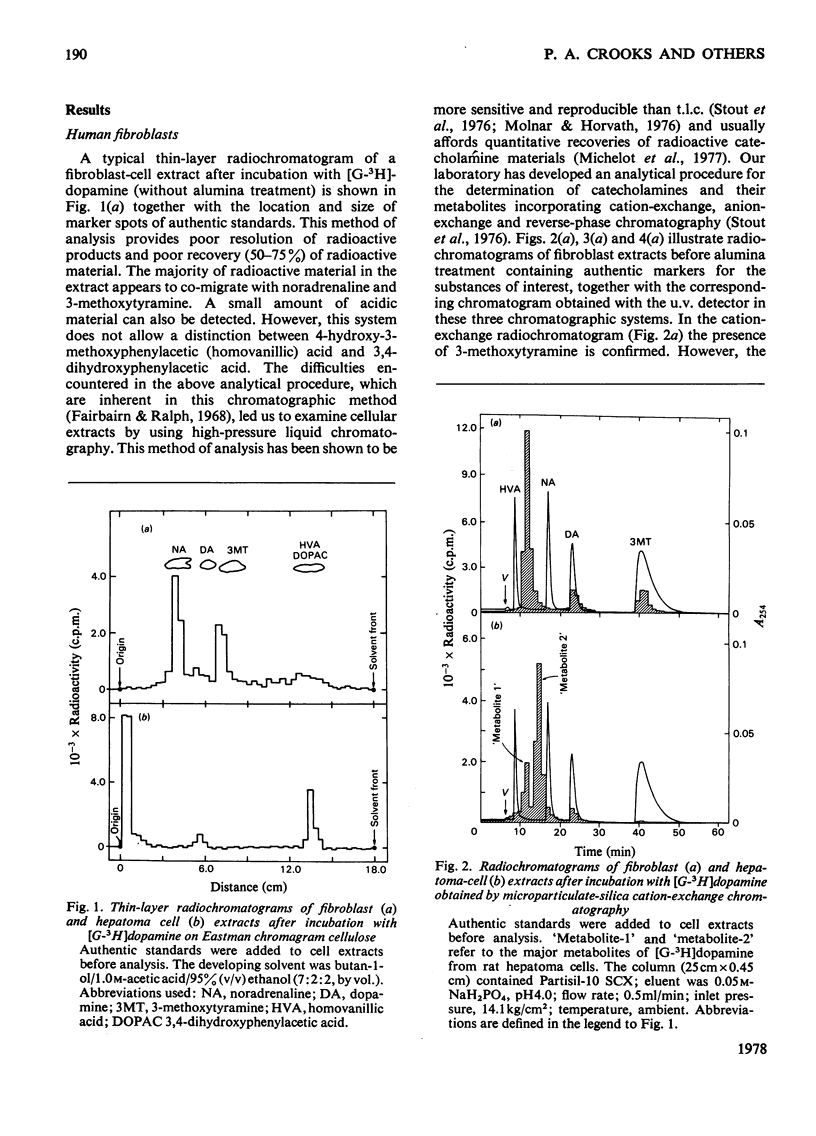
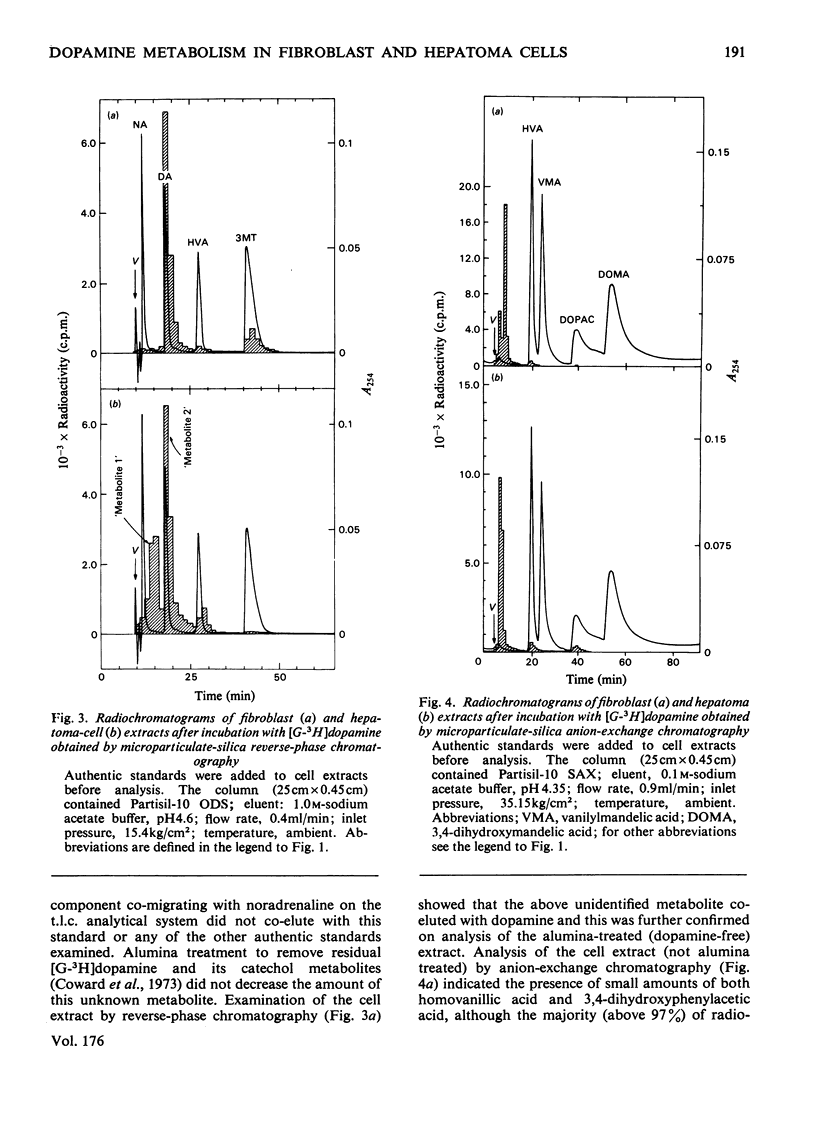
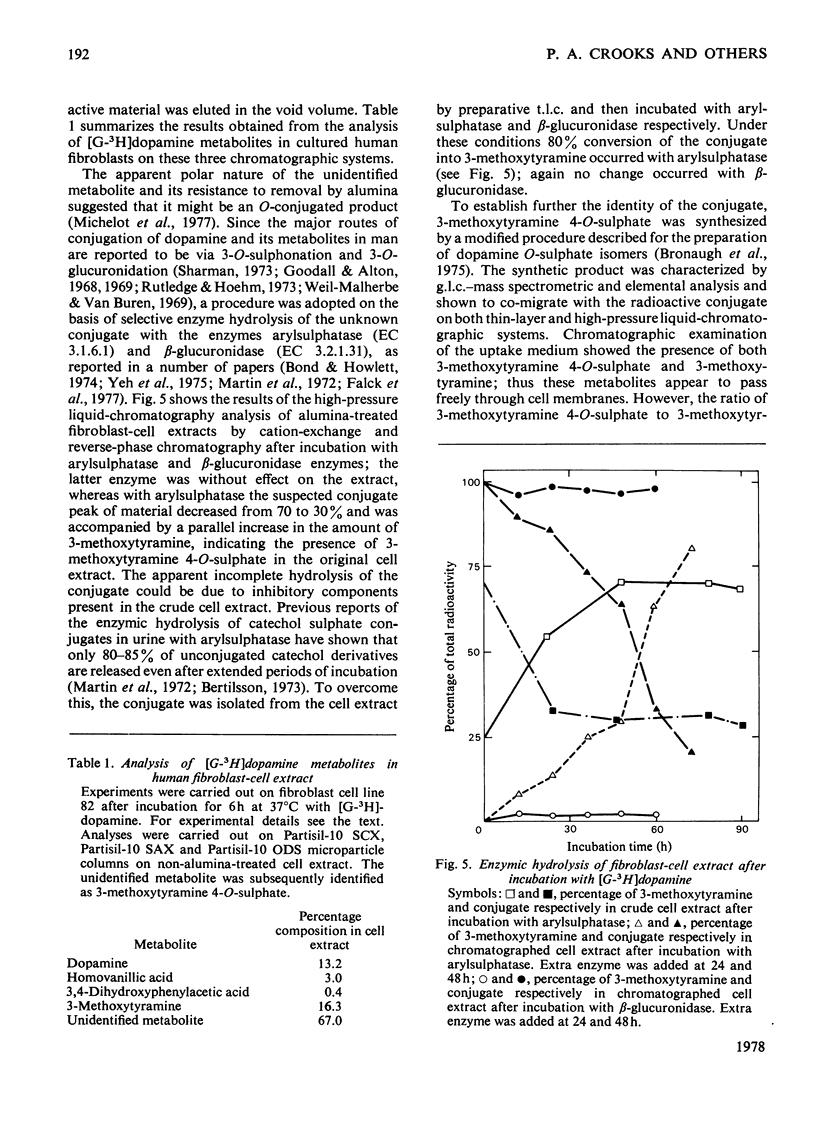



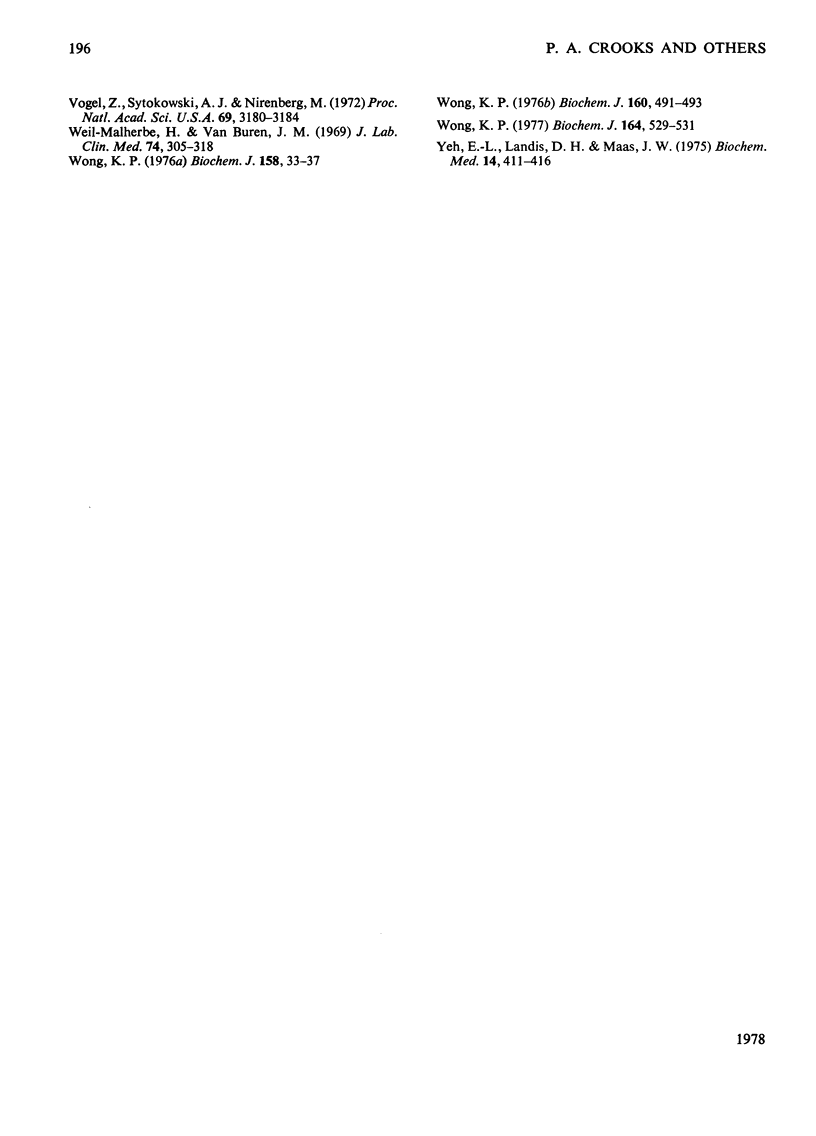
Selected References
These references are in PubMed. This may not be the complete list of references from this article.
- Bertilsson L. Quantitative determination of 4-hydroxy-3-methoxyphenyl glycol and its conjugates in cerebrospinal fluid by mass fragmentography. J Chromatogr. 1973 Dec 5;87(1):147–153. doi: 10.1016/s0021-9673(01)91527-4. [DOI] [PubMed] [Google Scholar]
- Bond P. A., Howlett D. R. Measurement of the two conjugates of 3-methoxy-4-hydroxyphenyglycol in urine. Biochem Med. 1974 Jul;10(3):219–228. doi: 10.1016/0006-2944(74)90025-8. [DOI] [PubMed] [Google Scholar]
- Breakefield X. O., Castiglione C. M., Edelstein S. B. Monoamine oxidase activity decreased in cells lacking hypoxanthine phosphoribosyltransferase activity. Science. 1976 Jun 4;192(4243):1018–1020. doi: 10.1126/science.1273584. [DOI] [PubMed] [Google Scholar]
- Breakefield X. O., Giller E. L., Jr Neurotransmitter metabolism in cell culture. Biochem Pharmacol. 1976 Nov 1;25(21):2337–2342. doi: 10.1016/0006-2952(76)90024-1. [DOI] [PubMed] [Google Scholar]
- Breakefield X. O. Reserpine sensitivity of catecholamine metabolism in murine neuroblastoma clone N1E-115. J Neurochem. 1975 Dec;25(6):877–882. doi: 10.1111/j.1471-4159.1975.tb04421.x. [DOI] [PubMed] [Google Scholar]
- Bronaugh R. L., Hattox S. E., Hoehn M. M., Murphy R. C., Rutledge C. O. The separation and identification of dopamine 3-O-sulfate and dopamine 4-O-sulfate in urine of Parkinsonian patients. J Pharmacol Exp Ther. 1975 Dec;195(3):441–452. [PubMed] [Google Scholar]
- Coward J. K., D'Urso-Scott M., Sweet W. D. Inhibition of catechol-O-methyltransferase by S-adenosylhomocysteine and S-adenosylhomocysteine sulfoxide, a potential transition-state analog. Biochem Pharmacol. 1972 Apr 15;21(8):1200–1203. doi: 10.1016/0006-2952(72)90114-1. [DOI] [PubMed] [Google Scholar]
- Coward J. K., Slixz E. P., Wu F. Y. Kinetic studies on catechol O-methyltransferase. Product inhibition and the nature of the catechol binding site. Biochemistry. 1973 Jun 5;12(12):2291–2297. doi: 10.1021/bi00736a017. [DOI] [PubMed] [Google Scholar]
- DODGSON K. S., WILLIAMS R. T. Studies in detoxication; the orientation of conjugation in the metabolites of 4-chlorocatechol and 4-chlororesorcinol, with some observations on the fate of (+)-adrenaline, protocatechuic acid and protocatechuic aldehyde in the rabbit. Biochem J. 1949;45(4):381–386. doi: 10.1042/bj0450381. [DOI] [PMC free article] [PubMed] [Google Scholar]
- Dodgson K. S., Smith J. N., Williams R. T. Studies in detoxication. 29. The orientation of glucuronic acid conjugation in chloroquinol. Biochem J. 1950 Jan;46(1):124–128. doi: 10.1042/bj0460124. [DOI] [PMC free article] [PubMed] [Google Scholar]
- Falck B., Hansson C., Kennedy B. M., Rosengren E. Conjugated catechol derivatives in a transplantable islet cell tumour of the golden hamster. Acta Physiol Scand. 1977 Feb;99(2):217–224. doi: 10.1111/j.1748-1716.1977.tb10372.x. [DOI] [PubMed] [Google Scholar]
- Goodall M., Alton H. Dopamine (3-hydroxytyramine) metabolism in parkinsonism. J Clin Invest. 1969 Dec;48(12):2300–2308. doi: 10.1172/JCI106196. [DOI] [PMC free article] [PubMed] [Google Scholar]
- Goodall M., Alton H. Metabolism of 3-hydroxytyramine (dopamine) in human subjects. Biochem Pharmacol. 1968 Jun;17(6):905–914. doi: 10.1016/0006-2952(68)90350-x. [DOI] [PubMed] [Google Scholar]
- Griffiths R., Tudball N. Studies on the use of skin fibroblasts for the measurement of cystathionine synthase activity with respect to homocystinuria. Clin Chim Acta. 1976 Nov 15;73(1):157–162. doi: 10.1016/0009-8981(76)90317-x. [DOI] [PubMed] [Google Scholar]
- HERTTING G. THE FATE OF 3H-ISO-PROTERENOL IN THE RAT. Biochem Pharmacol. 1964 Aug;13:1119–1128. doi: 10.1016/0006-2952(64)90112-1. [DOI] [PubMed] [Google Scholar]
- Hawkins M., Jr, Breakefield X. O. Monoamine oxidase A and B in cultured cells. J Neurochem. 1978 Jun;30(6):1391–1397. doi: 10.1111/j.1471-4159.1978.tb10471.x. [DOI] [PubMed] [Google Scholar]
- LOWRY O. H., ROSEBROUGH N. J., FARR A. L., RANDALL R. J. Protein measurement with the Folin phenol reagent. J Biol Chem. 1951 Nov;193(1):265–275. [PubMed] [Google Scholar]
- Martin B. R., Timmons M. C., Prange A. J., Jr Enzymatic hydrolysis of 3-methoxy-4-hydroxyphenethyl-eneglycol conjugates. Clin Chim Acta. 1972 May;38(2):271–275. doi: 10.1016/0009-8981(72)90115-5. [DOI] [PubMed] [Google Scholar]
- Michelot R. J., Lesko N., Stout R. W., Coward J. K. Effect of S-adenosylhomocysteine and S-tubercidinylhomocysteine on catecholamine methylation in neuroblastoma cells. Mol Pharmacol. 1977 Mar;13(2):368–373. [PubMed] [Google Scholar]
- Molnár I., Horváth C. Reverse-phase chromatography of polar biological substances: separation of catechol compounds by high-performance liquid chromatography. Clin Chem. 1976 Sep;22(9):1497–1502. [PubMed] [Google Scholar]
- Mudd S. H., Uhlendorf B. W., Freeman J. M., Finkelstein J. D., Shih V. E. Homocystinuria associated with decreased methylenetetrahydrofolate reductase activity. Biochem Biophys Res Commun. 1972 Jan 31;46(2):905–912. doi: 10.1016/s0006-291x(72)80227-4. [DOI] [PubMed] [Google Scholar]
- Roth J. A., Breakefield X. O., Castiglione C. M. Monoamine oxidase and catechol-O-methyltransferase activities in cultured human skin fibroblasts. Life Sci. 1976 Dec 1;19(11):1705–1710. doi: 10.1016/0024-3205(76)90077-1. [DOI] [PubMed] [Google Scholar]
- Rutledge C. O., Hoehn M. M. Sulphate conjugation and L-dopa treatment of Parkinsonian patients. Nature. 1973 Aug 17;244(5416):447–450. doi: 10.1038/244447b0. [DOI] [PubMed] [Google Scholar]
- Sharman D. F. The catabolism of catecholamines. Recent studies. Br Med Bull. 1973 May;29(2):110–115. doi: 10.1093/oxfordjournals.bmb.a070978. [DOI] [PubMed] [Google Scholar]
- Stout R. W., Michelot R. J., Molnar I., Horvath C., Coward J. K. An analytical method for the separation of dopamine metabolites in cellular extracts by high-pressure liquid chromatography. Anal Biochem. 1976 Nov;76(50):330–341. doi: 10.1016/0003-2697(76)90291-8. [DOI] [PubMed] [Google Scholar]
- Vogel Z., Sytkowski A. J., Nirenberg M. W. Acetylcholine receptors of muscle grown in vitro. Proc Natl Acad Sci U S A. 1972 Nov;69(11):3180–3184. doi: 10.1073/pnas.69.11.3180. [DOI] [PMC free article] [PubMed] [Google Scholar]
- Weil-Malherbe H., Van Buren J. M. The excretion of dopamine and dopamine metabolites in Parkinson's disease and the effect of diet thereon. J Lab Clin Med. 1969 Aug;74(2):305–318. [PubMed] [Google Scholar]
- Wong K. P. Species differences in the conjugation of 4-hydroxy-3-methoxyphenylethanol with glucuronic acid and sulphuric acid. Biochem J. 1976 Jul 15;158(1):33–37. doi: 10.1042/bj1580033. [DOI] [PMC free article] [PubMed] [Google Scholar]
- Wong K. P. The biosynthesis of tyramine glucuronide by liver microsomal fractions. Biochem J. 1977 Jun 15;164(3):529–531. doi: 10.1042/bj1640529. [DOI] [PMC free article] [PubMed] [Google Scholar]
- Wong K. P. The conjugation of tyramine with sulphate by liver and intestine of different animals. Biochem J. 1976 Dec 15;160(3):491–493. doi: 10.1042/bj1600491. [DOI] [PMC free article] [PubMed] [Google Scholar]
- Yeh E. L., Landis D. H., Maas J. W. A method for the preparation and separation of 3-methoxy-4-hydroxyphenethyleneglycol conjugates. Biochem Med. 1975 Dec;14(4):411–416. doi: 10.1016/0006-2944(75)90060-5. [DOI] [PubMed] [Google Scholar]


